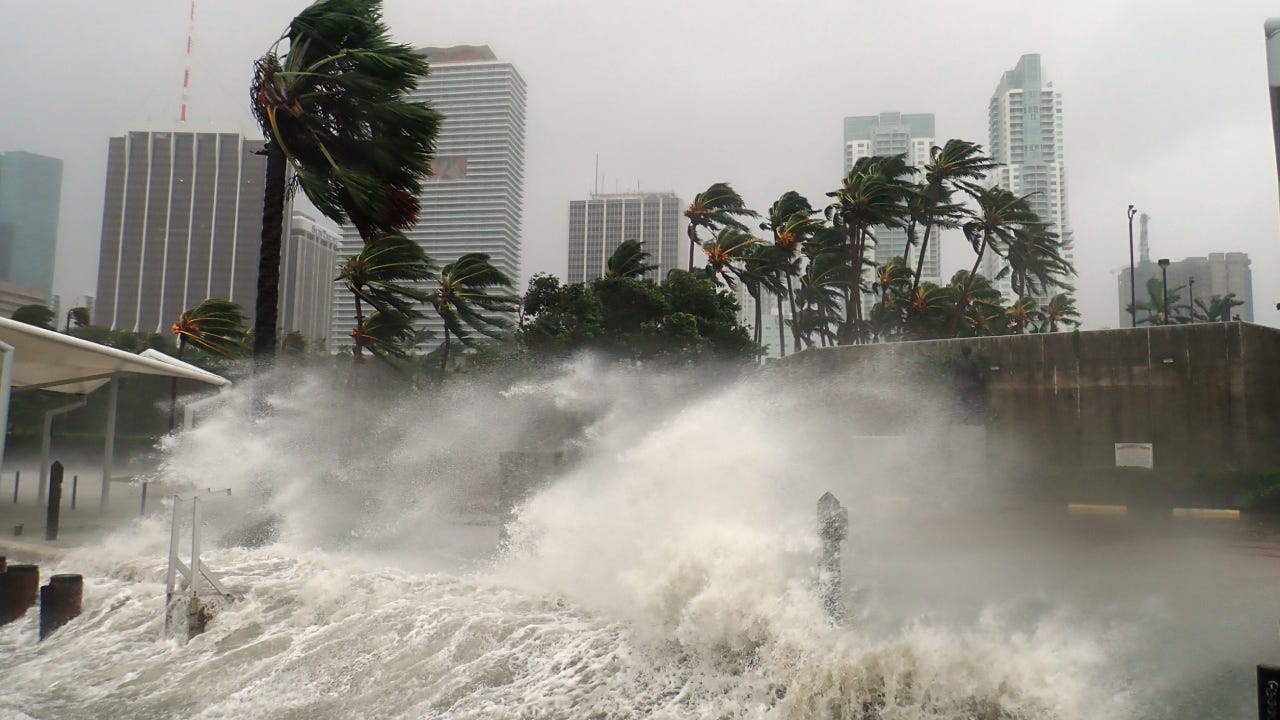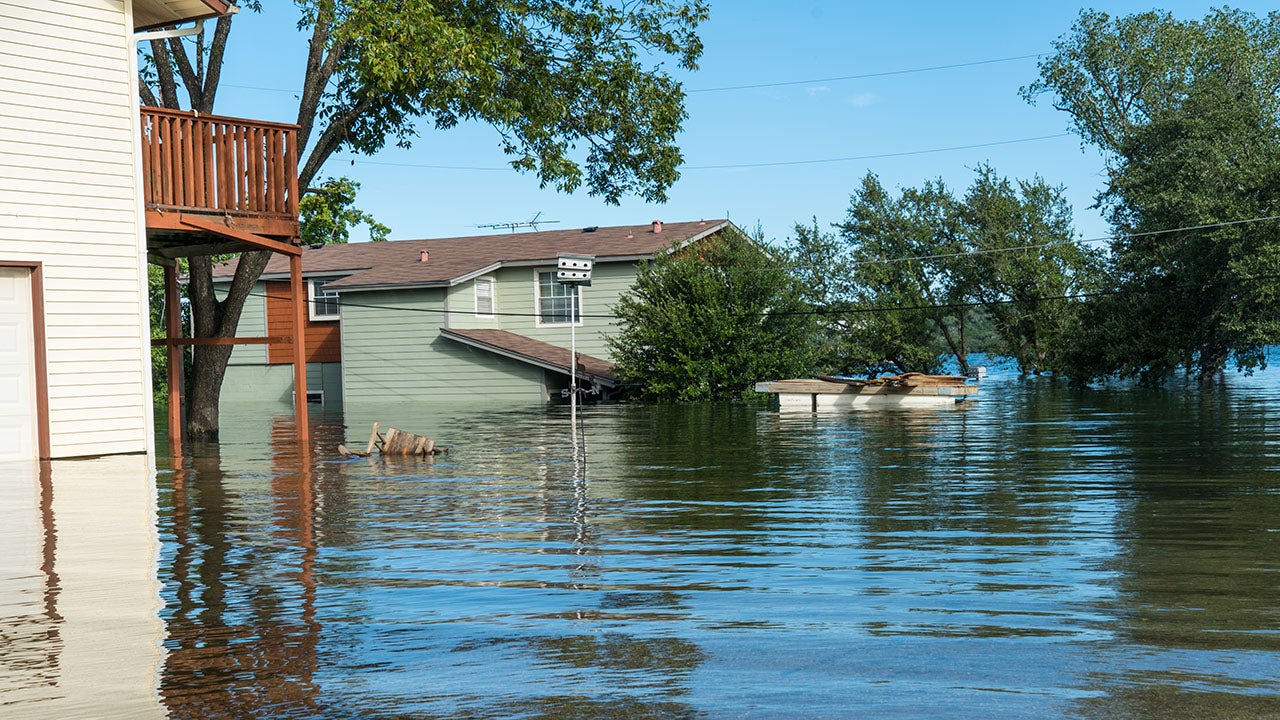Extreme weather is transforming the insurance industry — here’s what one expert recommends

Key takeaways
- In response to climate change, many insurers are shifting to a “predict and prevent” approach to property and casualty risks, rather than just covering damage when it happens.
- All areas of the U.S. are now subject to severe weather risks with the potential to generate insurance claims.
- Flood insurance may be a key part of a “climate-proof” insurance policy in 2024.
- Policyholders should work to fortify their homes and vehicles against severe weather and natural disasters in addition to investing in adequate coverage.
The U.S. insurance industry is in crisis, and climate change is a major player.
As extreme weather events become more frequent, natural disaster costs are contributing to rising insurance premiums for drivers and homeowners. In states like California and Florida, climate-driven disasters, like wildfires and hurricanes, have made home insurance — and with it, homeownership — less affordable for many Americans.
Where does this leave homeowners and vehicle owners who need coverage that they increasingly can’t afford? To get an industry expert’s perspective on how climate change is impacting the U.S. insurance market, we spoke to Mark Friedlander, director, corporate communications at the Insurance Information Institute (Triple-I) and a member of Bankrate’s expert review board.
Our interview with Mark Friedlander
Mark Friedlander has been active in the insurance industry for decades. Based in St. Johns County, Florida, he served in a consultant role with the Insurance Institute for Business & Home Safety and 13 years as head of corporate communications at the property and casualty insurer Main Street America Insurance before joining the Triple-I in the summer of 2019.
Bankrate: Climate change — which is increasing the rate of severe weather incidents and natural disasters in many areas of the U.S. — is a major factor in the recent increase in property insurance rates in the past few years. What strategies are insurers using to address the impact of climate change and avoid a future of constantly snowballing rate hikes?
Mark Friedlander: The insurance industry is shifting to a “predict and prevent” approach to risk management versus the prior approach of replacing and repairing properties following losses. Predicting and preventing losses leads to less volume of claims and less severe claims, generating better rates for all policyholders.
Property/casualty insurers are minimizing losses and transforming areas like home safety and disaster management. For example, programs like the Insurance Institute for Business & Home Safety’s FORTIFIED construction standards are making communities more resilient to windstorms.
- According to Bankrate’s Severe Weather Financial Impact Survey, 57% of U.S. adults say they have incurred costs due to an extreme weather event in the past 10 years.
- 20 percent of U.S. adults say they incurred expenses as a result of home or property damage caused by an extreme weather event within the past 10 years.
- 13 percent of U.S. adults say they incurred costs from car damage resulting from an extreme weather event within the past 10 years.
- 24 percent of U.S. adults expect severe weather to have a “very negative” impact on their personal finances in the next 10 years.
BR: Which areas of the U.S. are seeing the biggest climate impacts on insurance? Is it limited to traditionally high-risk areas like Florida and other coastal regions, or are new high-risk spots cropping up in unexpected places?

MF: No area of the U.S. is immune to the impacts of climate risk. Whether it’s hurricanes, wildfires, severe convective storms, tornadoes, floods, hailstorms, straight-line winds or damage from heavy snow or ice accumulation, every county in every state is vulnerable to a multitude of risks.
It’s essential that policyholders own their risk. This means they need to assess the risks they face where they live and determine what insurance coverage is essential to be financially protected from losses.
According to an analysis by the Insurance Information Institute (Triple-I), a major factor in the rising costs of weather and climate losses is more people living in harm’s way of catastrophes.
When Hurricane Ian, a Category 4 major hurricane, struck the southwest Florida coast in September 2022, it caused an estimated $60 billion in insured losses, making it the second-largest natural disaster behind 2005’s Hurricane Katrina (approximately $96 billion in today’s dollars). Florida has incurred many major hurricanes in the past. The difference with Ian was the massive population growth of this area of Florida over the past two decades.
Another significant factor in rising disaster loss costs is inflation. From the period 2019-2022, replacement costs spiked 56 percent, nearly four times the U.S. inflation rate. This is due to supply chain disruption, the rising costs of construction materials and labor shortages.
According to a 2023 consumer survey conducted by Triple-I and Munich Re, 12 percent of U.S. homeowners have decided not to purchase property insurance, more than double the pre-pandemic level (5 percent). This is an alarming trend as most Americans cannot afford to pay for a significant loss to their home out of pocket.
- According to Bankrate’s 2024 Annual Emergency Savings Report, 27% of U.S. adults have no emergency savings as of May 2024.
- 36 percent of U.S. adults have more credit card debt than emergency savings, as of January 2024.
- Only 44 percent of U.S. adults would pay for an emergency expense of $1,000 out of savings, while 21 percent would finance the expense with a credit card and 10 percent would borrow from family or friends, as of December 2023.
BR: Do you anticipate any major changes in the way insurers do business as a result of climate change — such as new underwriting practices or new types of coverage?
MF: A significant change in property insurance underwriting involves increased usage of aerial technology to inspect homes. More insurers are engaging drones to inspect properties. This not only is a more cost-effective, efficient and safer approach to inspections versus the traditional approach of sending an inspector out to your home to climb on your roof, but the aerial inspections capture much more precise data about the condition of homes, particularly roofs. Aerial inspections may also capture unreported additions to homes that are not included on the insurance policy, such as an in-ground swimming pool or a trampoline in the backyard.
Roofs are considered the first line of defense to severe weather events, so it is essential that the condition of a home’s roof meets the underwriting standards of the property’s insurer. The goal of technologically advanced underwriting is to write the best risks and reduce claims, which benefits all policyholders with better pricing.
BR: The impacts of climate change are more obvious in the case of home insurance. Should car owners who don’t have home insurance also be worried about the increased incidence of severe weather and natural disasters?
MF: Vehicle owners should have adequate insurance coverage to protect their cars, trucks and SUVs from severe weather and natural disasters. This means purchasing optional comprehensive coverage, which about 80 percent of U.S. drivers carry. Comprehensive protects the vehicle from non-collision hazards including wind, hail, flood, fire, as well as theft and vandalism. If you have a car loan or lease, you will typically be required to carry this coverage.
BR: What does a climate-proof insurance policy look like — that is, what types and levels of coverage are advisable for home and car owners going forward?
MF: Having the right types and levels of insurance coverage is essential for financial protection from the hazards caused by climate risk. This includes having flood insurance no matter where you live. As 90 percent of U.S. natural disasters involve flooding, no area of the country is immune to this hazard. Yet, less than 10 percent of U.S. homeowners carry flood insurance through either the federally backed National Flood Insurance Program (NFIP) or a private flood insurer.
Flood insurance is the largest insurance gap we see across the country. There is also a significant knowledge gap as many homeowners assume flood coverage is included in their home or renters policy.
- As of September 2023, the average cost of flood insurance through the NFIP is $800 per year.
- Connecticut has the highest average annual cost of flood insurance at $1,298 per year.
- Flood insurance is cheapest in Alaska and Utah, at an average of $633 and $639 per year, respectively.
- Mortgage lenders typically require flood insurance for homes in FEMA-designated flood zones.
BR: What steps can consumers take today to manage their climate risk?
MF: In addition to financial protection provided by adequate insurance coverage, homeowners can fortify their homes against the wrath of Mother Nature.
If you live in an area prone to windstorms, such as tornadoes and hurricanes, there are many steps a homeowner can take to fortify their property. Invest in items that will harden your property against wind damage, such as roof tie-downs, a wind-rated garage door and storm shutters. Triple-I also recommends having your roof inspected annually by a licensed and bonded contractor to make sure it will withstand high winds and torrential rains.
If you live in an area prone to wildfires, you can harden your home by installing Class A fire-rated roofs, metal screens that cover all vents and double or multi-paned tempered glass windows. You can also create a defensible space around the perimeter of the home. This means making sure it is free of leaves, wood mulch, debris or other flammable materials up to 200 feet from a structure.
The future of insurance in America
While inflation may ease up in the coming years, the ongoing impacts of climate change may mean that high insurance premiums are the new normal for many Americans. Friedlander’s insights suggest that the way forward for many consumers means understanding and addressing the new reality of climate risk in proactive ways:
- Understand your area’s risk factors: As climate change reshapes local risks, you may be subjected to threats you’re not aware of. First Street’s Risk Factor tool is a good starting place to understand your home and vehicle’s level of climate risk.
- Know what your policy covers — and what it doesn’t: Flood insurance may be a major gap in your home’s financial defenses. Look into options to get flood insurance in your area.
- Predict and prevent: Your home and auto insurance are there if you need to file a claim, but avoiding damage in the first place is one of the best ways to keep your coverage affordable. Take steps to fortify your home and practice defensive driving habits, especially in severe weather conditions.
- Shop often: As insurers innovate to avoid climate-related financial losses, home and auto insurance rates may change frequently. Shopping whenever your policy is up for renewal could help you avoid overpaying for the coverage you need.
The better you understand your insurance policies, the better equipped you’ll be to adapt your insurance to a changing landscape. Shopping often, reviewing your policy before each renewal and talking to a licensed insurance agent are all ways to increase your insurance literacy and stay in control of costs.
You may also like

Rising tides and insurance costs: Coastal homeowners navigate high coverage costs

Does homeowners insurance cover flooding?




